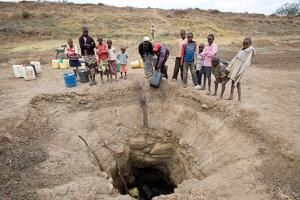
Locals in the village of Kalele in Kenya’s Eastern Province gather what water they can from a hand dug well located at the site of a large scale dam project built in 2008 through Caritas Kenya. The dam, built through the Katangi Food Security Support Project, provided year round water to the local communities for two years. The withering drought the region now faces has dried the surface water of the 21,000 cubic meter pond.
Credits: David Snyder/Caritas
Caritas Internationalis humanitarian director Alistair Dutton explains why Caritas has a big focus on harvesting and storing water in drought-hit East Africa.
The simple answer to a drought should be for it to rain lots. The crops would grow, the animals would get fed and people would know where their next meal and drink would be coming from.
People are desperate for rain in East Africa where up to 13 million people need emergency assistance because of one of the worst droughts in 60 years. But it’s not the simple solution it seems.
Alistair Dutton, humanitarian director for Caritas Internationalis has just returned from a trip to Ethiopia and Kenya. He met with Caritas member organisations working in these countries to discuss the best short- and long-term answers to the devastating hunger crisis caused by the drought.
“We went to a village and scores of people were sitting under trees. They had gathered from a wide area and they were praying for rain,” says Alistair. “But if it did rain in many places it would just flow away and strip the top soil after years of environmental degradation.”
“At the moment there’s a sense of resignation in the drought-hit places I saw on my visit. They are coping with very few resources. People are sitting it out and hoping that the rains come when they should over the next few months,” says Alistair.
Undeniably, rain would help return some green to the parched landscape in the drought-affected areas, however, again this doesn’t provide the simple solution you’d think.
“After the rains, green shoots appear within a week. But you’ll see pastoralists beating their hungry animals away from the crops. In their starved state animals will eat and eat and this itself can kill them when they’ve been without adequate food for so long,” says Alistair.
He goes on to explain that a lot of Caritas’ work in drought-hit zones is focused on slowing rivers and streams down so when it rains the water can soak into the ground and can refill boreholes and ponds.
He says that Caritas helps communities have access to water during dry seasons by working with them to build bore holes, micro-dams, ponds, reservoirs and install water points (see pictures for Ethiopia and Kenya ). In addition, Caritas provides resilient breeds of goat and drought-resistant seeds and teaches farmers agricultural techniques which will help them through the dry periods.
“This is the third major drought in this region in the past six years. A lot of the problem is due to chronic under-development and a lack of investment in farming and infrastructure. Until there’s a whole programme of investment in agriculture and the environment, the rains will just continue to flow away,” says Alistair.
